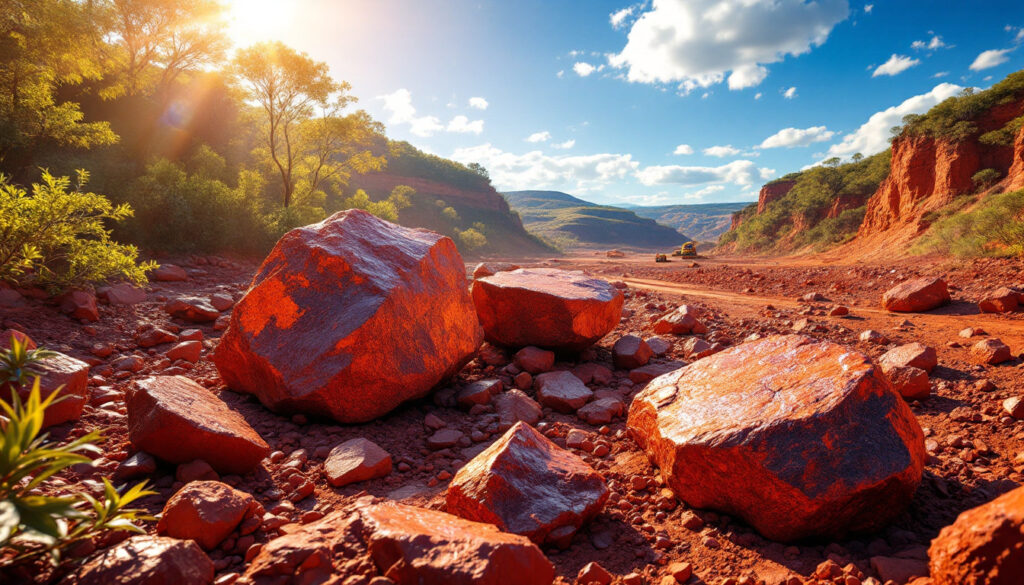The World’s Ten Largest Iron Ore Mines in 2025
In the global mining landscape, iron ore operations stand as titans of industry, producing the essential raw material that underpins modern infrastructure worldwide. With more than 922 iron ore mines currently operating across the globe, according to GlobalData’s comprehensive mining database, the sector represents one of the most significant extractive industries on the planet.
The scale of these operations is staggering, with the largest facilities capable of producing over 100 million tonnes of iron ore annually—enough to build approximately 70,000 Eiffel Towers each year. These mining giants not only shape global commodity markets but also the economic fortunes of their host nations.
Understanding Global Iron Ore Production
The geography of iron ore production reveals a remarkably concentrated industry. Australia and Brazil dominate global output, together accounting for approximately 75% of seaborne iron ore trade. This concentration is reflected in the ownership of the world’s ten largest mines, with seven located in Western Australia’s mineral-rich Pilbara region and three situated in Brazil.
While China consumes over 70% of globally traded iron ore, it’s notable that none of its domestic mines ranks among the world’s largest producers. This disparity between consumption and production creates a critical strategic vulnerability for the world’s largest steel producer, driving its companies to secure mining rights abroad.
The Scale of Global Iron Ore Mining
The sheer magnitude of modern iron ore operations is difficult to comprehend. The largest mines move hundreds of millions of tonnes of material annually, utilizing massive equipment including haul trucks with capacities exceeding 400 tonnes and excavators that can move 4,500 tonnes of material per hour.
What distinguishes these elite operations is not merely their size but their operational efficiency. The top-tier mines typically achieve operating costs below $25 per tonne, significantly lower than the global average of $41 per tonne. This cost advantage provides crucial protection during market downturns and periods of iron ore price volatility.
Iron Ore Production by Region
Western Australia’s dominance in iron ore production is no accident. The region’s geological advantages include extraordinarily high-grade hematite deposits (often exceeding 60% Fe content) that require minimal processing, combined with proximity to deep-water ports and relatively short shipping routes to Asian markets.
Brazil’s iron ore industry, while smaller than Australia’s in total volume, boasts the world’s highest-grade commercial deposits in the Carajás region, where ore grades frequently exceed is astonishing 67% Fe content—a quality advantage that commands premium pricing in the market.
Key Mining Companies in Iron Ore Production
Four mining giants control nine of the world’s ten largest iron ore operations:
- Vale (Brazil) operates the world’s largest and second-largest mines, leveraging Brazil’s exceptional ore quality to maintain market share despite longer shipping distances to Asian markets.
- BHP Group (Australia) controls four of the top ten mines, making it the dominant player by number of elite operations.
- Rio Tinto (Australia) manages two top-ten mines and has pioneered mining automation technologies that have transformed the industry.
- Fortescue (Australia), a relative newcomer founded in 2003, has rapidly established itself with two massive operations, demonstrating how technology can overcome the challenge of lower-grade deposits (typically 56-59% Fe) compared to its competitors.
What Makes a World-Class Iron Ore Mine?
World-class iron ore operations share several distinguishing characteristics beyond mere production volume. These elite mines integrate advanced geological understanding, operational excellence, and strategic infrastructure development to maintain their competitive advantage.
Production Capacity Metrics
Annual production capacity serves as the primary metric for ranking iron ore operations, with the world’s top mines producing between 47-103 million tonnes annually. However, equally important is production consistency—the ability to maintain output levels despite seasonal challenges like Western Australia’s cyclone season or Brazil’s rainy periods.
Production efficiency, measured as ore moved per employee, has become increasingly important. The most efficient operations now achieve productivity exceeding 75,000 tonnes per employee annually, nearly triple the industry average of 25,000-30,000 tonnes.
Operational Lifespan
The world’s premier iron ore mines are characterized by extraordinary longevity. Area C Mine in Western Australia, with operations projected to continue until 2067, exemplifies this extended lifecycle. These lengthy operational timelines enable mining companies to justify massive infrastructure investments, including dedicated railways and port facilities.
However, maintaining such longevity requires continuous exploration investment. BHP, for example, allocates approximately $80 million annually to near-mine exploration around its Western Australian operations to extend mine life through resource expansion.
Mining Methods
Surface mining dominates large-scale iron ore extraction, offering several advantages over underground methods, including:
- Higher recovery rates (typically 90-95% versus 60-75% for underground operations)
- Lower operational costs (approximately 40-60% less per tonne)
- Superior safety performance with significantly lower injury rates
- Greater adaptability to automated equipment and systems
The industry’s exclusive use of surface mining among top producers reflects these compelling economics, though it comes with greater environmental footprint considerations that are increasingly being addressed through decarbonisation in mining initiatives.
The Top 10 Iron Ore Mines by Production (2023)
10. Christmas Creek Mine
Located in Western Australia’s Pilbara region, Fortescue’s Christmas Creek operation produced 47.01 million tonnes in 2023. The mine employs advanced dry processing technology to maximize water conservation in the arid region, recycling approximately 85% of water used in operations.
Expected to operate until 2031, Christmas Creek pioneered Fortescue’s autonomous haulage program, with over 180 autonomous trucks now operating across the company’s Pilbara network. This automation has improved productivity by 30% while reducing safety incidents by 40%.
9. Yandicoogina Mine
Rio Tinto’s Yandicoogina operation delivered 51.1 million tonnes in 2023. This Western Australian mine is noteworthy for its channel iron deposit (CID) formation—a relatively rare geological structure where ancient riverbed deposits created concentrated iron formations.
With operations projected through 2039, Yandicoogina was Rio Tinto’s first fully autonomous mine, implementing the company’s AutoHaul system to create the world’s largest robot—a fully autonomous heavy-haul railway system operating over 1,700 kilometers of track.
8. Kings Valley Mine
Producing 51.29 million tonnes in 2023, Fortescue’s Kings Valley operation in Western Australia represents the company’s most technologically advanced site. The mine features the industry’s first completely autonomous drill fleet, with 20 autonomous drills operating without direct human control.
Kings Valley’s ore requires additional processing compared to some competitors’ mines, as its average grade of 57.5% Fe falls below the benchmark 62% standard. To overcome this quality gap, Fortescue invested $1.3 billion in the Kings Valley beneficiation plant, which upgrades ore through crushing, screening, and magnetic separation.
7. Greater Tom Price Mine
Rio Tinto’s flagship Greater Tom Price operation produced 51.62 million tonnes in 2023. As the company’s first Pilbara mine, beginning operations in 1966, Tom Price holds historical significance as the site that established Western Australia’s iron ore industry.
Expected to continue operations through 2035, the mine is undergoing a $1 billion modernization program. The Western Turner Syncline extension, approved in 2020, is extending mine life while implementing advanced technologies including autonomous trucks and remote operations capability linked to Rio Tinto’s Perth operations center 1,500 kilometers away.
6. South Flank Project
BHP Group’s newest mega-mine delivered 56 million tonnes in 2023 after reaching full production capacity in record time. The $3.6 billion development represents Australia’s largest iron ore mining and processing facility developed in the past 50 years.
With operations planned through 2047, South Flank was designed as a digital-first operation, featuring 41 autonomous trucks, 37 autonomous drills, and over 200 sensors monitoring ore quality in real-time. This technology integration allows the mine to maintain precise ore blending targets that maximize product value.
5. Area C Mine
BHP Group’s Area C produced 58.47 million tonnes in 2023. With the longest projected lifespan among the top ten (until 2067), Area C’s exceptional longevity stems from its massive geological endowment—estimated reserves exceeding 2 billion tonnes.
The operation has pioneered environmental initiatives including the first large-scale renewable energy implementation in Australian mining. A 30MW solar farm coupled with battery storage provides approximately 40% of the mine’s daytime power requirements, reducing carbon emissions by an estimated 50,000 tonnes annually.
4. Jimblebar Hub
With production of 66.8 million tonnes in 2023, BHP’s Jimblebar Hub represents one of the mining industry’s most successful automation implementations. The operation was the first to deploy autonomous haulage at scale, with its entire fleet of 50 Caterpillar 793F trucks operating without drivers.
Planning to operate until 2060, Jimblebar has achieved a 20% productivity improvement over comparable manned operations while reducing safety incidents by 90%. The site’s remote operations center in Perth allows a single operator to monitor up to eight autonomous trucks simultaneously.
3. Mt Newman Joint Venture
BHP Group’s Mt Newman Joint Venture delivered 66.99 million tonnes in 2023. The operation, which includes multiple pits across a vast license area, benefits from exceptional ore quality with an average grade of 62.5% Fe—slightly above the industry benchmark.
Expected to operate through 2052, Mt Newman’s competitive advantage includes direct ownership of dedicated rail infrastructure through the 426km Mt Newman railway. This vertically integrated logistics system reduces transportation costs to approximately $5 per tonne, compared to industry averages of $7-10 per tonne.
2. Carajas Serra Sul S11D Project
Vale’s technological showpiece in Brazil’s Para state produced 76.67 million tonnes in 2023. The $14.3 billion development represents mining’s most ambitious attempt to minimize environmental impact while maximizing production efficiency.
Operating until 2059, S11D implemented a revolutionary “truckless” mining system utilizing 37 kilometers of conveyor belts instead of traditional haul trucks. This approach reduced diesel consumption by 77% and carbon emissions by 50% compared to conventional mining methods. Perhaps most impressively, the operation preserved 90% of the native vegetation within its project area.
1. Serra Norte Mining Complex
Vale’s Serra Norte complex in Brazil claimed the title of world’s largest iron ore mine with production of 102.8 million tonnes in 2023. The operation’s dominant position stems from extraordinary geological advantages—ore grades averaging 67% Fe, approximately 5% higher than Australian competitors.
With operations projected through 2038, Serra Norte benefits from exceptional economies of scale. Despite being located nearly 900 kilometers from the coast, Vale’s integrated logistics system (including the dedicated Carajás Railway) achieves delivered costs to Asian markets comparable to Australian producers despite the significantly longer shipping distance.
How Do These Mines Compare?
Production Capacity Comparison
| Rank | Mine | Production (2023) | Owner |
|---|---|---|---|
| 1 | Serra Norte Mining Complex | 102.8 mtpa | Vale |
| 2 | Carajas Serra Sul S11D Project | 76.67 mtpa | Vale |
| 3 | Mt Newman Joint Venture | 66.99 mtpa | BHP Group |
| 4 | Jimblebar Hub | 66.8 mtpa | BHP Group |
| 5 | Area C Mine | 58.47 mtpa | BHP Group |
| 6 | South Flank Project | 56 mtpa | BHP Group |
| 7 | Greater Tom Price Mine | 51.62 mtpa | Rio Tinto |
| 8 | Kings Valley Mine | 51.29 mtpa | Fortescue |
| 9 | Yandicoogina Mine | 51.1 mtpa | Rio Tinto |
| 10 | Christmas Creek Mine | 47.01 mtpa | Fortescue |
This production data reveals Brazilian operations’ disproportionate impact—Vale’s two mines account for just 20% of the top ten operations but contribute nearly 30% of their combined production. The remarkably tight clustering between ranks 7-9 (all within 0.5 mtpa of each other) demonstrates the intense competition in the industry’s second tier.
Operational Lifespan Analysis
The projected operational timelines of these elite mines reveal strategic positioning for market dominance over coming decades:
- Area C Mine (until 2067): BHP’s longest-lived asset positions the company for sustained market presence over 40+ years.
- Jimblebar Hub (until 2060): Enhanced by automation that extends economic viability of lower-grade sections.
- Carajas Serra Sul S11D Project (until 2059): Vale’s newest operation benefits from the world’s richest undeveloped iron ore deposit.
- Mt Newman Joint Venture (until 2052): Continuous exploration expands resources beyond original projections.
These extended operational timelines provide crucial stability in an industry characterized by massive capital requirements and lengthy development timeframes. New world-class iron ore mines typically require 7-10 years from discovery to production and capital investments exceeding $3 billion.
The Future of Iron Ore Mining
Technological Advancements
The iron ore industry stands at the forefront of mining technology adoption, with several transformative trends reshaping operations:
Autonomous mining systems have progressed beyond experimental status to become standard at elite operations. Rio Tinto’s AutoHaul system—the world’s first autonomous heavy haul railway—moves over 1 million tonnes of iron ore daily without drivers. Industry analysts estimate automation reduces operating costs by 15-20% while improving safety metrics by 40-60%.
Digital transformation in mining has accelerated with digital twins—virtual replicas of physical mining operations—enabling predictive maintenance and operational optimization. BHP’s digital twin implementation at South Flank reportedly identified $36 million in annual cost savings during its first year of operation.
Ore sorting technologies using sensors and artificial intelligence are revolutionizing processing. These systems can identify and separate waste rock before crushing, reducing energy consumption by 15-30% while improving recovered grade by 2-5%.
Environmental Considerations
Iron ore miners face intensifying pressure to reduce environmental impacts while maintaining cost competitiveness:
Water management has become critical, with the industry investing heavily in recycling systems. Rio Tinto’s Pilbara operations now recycle 75% of water used, reducing fresh water consumption by approximately 40 billion liters annually—equivalent to 16,000 Olympic swimming pools.
Renewable energy adoption is accelerating, with Fortescue Metals Group committing to carbon neutrality by 2030—the most ambitious target among major miners. The company’s Pilbara Energy Connect project will deploy 150MW of solar capacity supported by battery storage, potentially reducing diesel consumption by 100 million liters annually.
Rehabilitation techniques have advanced dramatically. Modern mine closure plans incorporate progressive rehabilitation during operations, reducing final closure costs by up to 40% while improving ecological outcomes. BHP’s Pilbara operations have rehabilitated over 23,000 hectares of disturbed land to date.
Market Outlook for Iron Ore
The long-term market dynamics for iron ore reveal complex interplays between supply, demand, and technological evolution:
China’s steel consumption patterns are evolving from infrastructure-driven to consumer-oriented, potentially moderating growth rates. However, analysts project India’s steel demand will double by 2030, creating a significant new market driver.
High-grade ore premiums will likely increase as environmental regulations tighten globally. Vale’s higher-grade Brazilian ores may command premiums exceeding $15 per percentage point above the 62% benchmark compared to current $4-7 premiums.
Production costs face upward pressure as easily accessible deposits deplete, pushing miners toward deeper, more complex resources. Industry analysts project average production costs rising approximately 2% annually in real terms, highlighting the importance of technological innovation to maintain margins.
Green steel initiatives using hydrogen rather than coal for reduction could transform demand patterns, potentially favoring higher-grade ores. This technological shift represents both threat and opportunity for established producers and will significantly impact Canberra’s iron ore price forecast in coming years.
FAQ About the World’s Largest Iron Ore Mines
What is the largest iron ore mine in the world?
The Serra Norte Mining Complex in Para, Brazil, operated by Vale, stands as the world’s largest iron ore producer with output of 102.8 million tonnes in 2023. The operation’s exceptional scale stems from its extraordinary geological endowment—ore grades averaging 67% Fe—and Vale’s $14+ billion investments in mining and logistics infrastructure.
Which country has the most top iron ore mines?
Australia dominates the ranking with seven of the world’s ten largest iron ore operations, all located in Western Australia’s Pilbara region. This concentration reflects both geological fortune and strategic investment in infrastructure, with over $60 billion invested in the region’s mining capabilities since 2010.
Which company operates
Looking for the Next Big Mineral Discovery?
Discover significant ASX mineral announcements in real-time with Discovery Alert’s proprietary Discovery IQ model, which transforms complex data into actionable investment insights. Explore why historic discoveries can generate substantial returns by visiting Discovery Alert’s dedicated discoveries page and start your 30-day free trial today.




